 W
WA floor is the bottom surface of a room or vehicle. Floors vary from simple dirt in a cave to many-layered surfaces made with modern technology. Floors may be stone, wood, bamboo, metal or any other material that can support the expected load.
 W
WA balcony is a platform projecting from the wall of a building, supported by columns or console brackets, and enclosed with a balustrade, usually above the ground floor.
 W
WA bamboo floor is a type of flooring manufactured from the bamboo plant. The majority of today's bamboo flooring products originate in China and other portions of Asia. Moso bamboo is the species most commonly used for flooring.
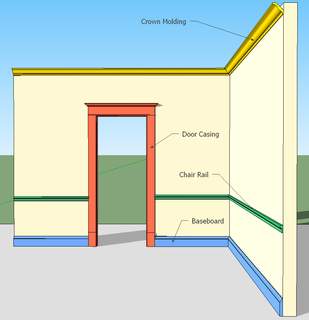 W
WIn architecture, a baseboard is usually wooden or vinyl board covering the lowest part of an interior wall. Its purpose is to cover the joint between the wall surface and the floor. It covers the uneven edge of flooring next to the wall; protects the wall from kicks, abrasion, and furniture; and can serve as a decorative molding.
 W
WCarpet cleaning is performed to remove stains, dirt, and allergens from carpets. Common methods include hot water extraction, dry-cleaning, and vacuuming.
 W
WA carpet sweeper is a mechanical device for the cleaning of carpets. They were popular before the introduction of the vacuum cleaner and have been largely superseded by them. However, they continue to be used in many home and commercial applications because they are lightweight and quiet, enabling users to quickly clean small messes up from the floor without disturbing patrons, patients, babies and pets, and because they do not require electricity to operate.
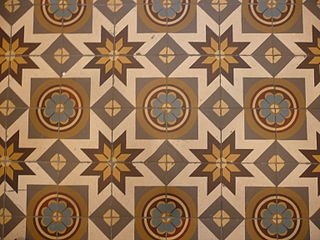 W
WCement tiles or hydraulic tiles are handmade colourful tiles used as floor and wall tiling. They appeared in Catalonia (Spain) in the 1850s, and have been widely used in Europe and America. They represented a revolution in flooring in their day because they were much cheaper, more durable and easier to make than the previous handmade glazed ceramic tiles and were therefore more universally available for houses, and they allowed for profuse decorative patterns, their age of splendour being the end of the 19th to the middle of the 20th centuries, before they were gradually superseded by newer technology as of the 1960s, such as terrazzo, salt-glazed stoneware, etc. that didn't allow for such decorative embellishment but were cheaper.
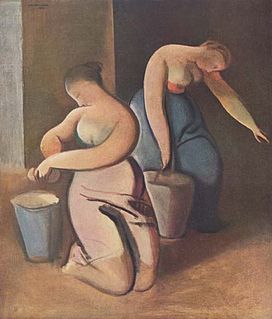 W
WFloor cleaning is a major occupation throughout the world. The main job of most cleaners is to clean floors.
 W
WA concrete moisture meter is a type of moisture meter used by installers of flooring to measure the moisture levels of concrete. These meters have been used for decades to measure the moisture content in different materials and substances. Concrete meters have evolved from the successful wood moisture meter as flooring contractors tried to use their wood meters to measure the moisture in concrete.
 W
WCrown molding is a form of cornice created out of decorative molding installed atop an interior wall. It is also used atop doors, windows, pilasters and cabinets.
 W
WA dais or daïs is a raised platform at the front of a room or hall, usually for one or more speakers or honored guests.
 W
WDate Palm Leaf Pati, is a traditional handmade furniture and house decoration. It was part of the cultural heritage of the village of Bengal, but fell out of use.
 W
WIn architecture, a deck is a flat surface capable of supporting weight, similar to a floor, but typically constructed outdoors, often elevated from the ground, and usually connected to a building. The term is a generalization of decks as found on ships.
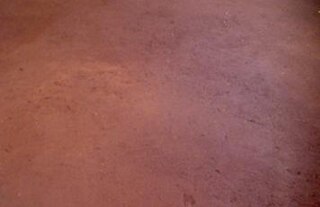 W
WAn earthen floor, also called an adobe floor, is a floor made of dirt, raw earth, or other unworked ground materials. It is usually constructed, in modern times, with a mixture of sand, finely chopped straw and clay, mixed to a thickened consistency and spread with a trowel on a sub-surface such as concrete. Once dry, it is then usually saturated with several treatments of a drying oil.
 W
WEncaustic tiles are ceramic tiles in which the pattern or figure on the surface is not a product of the glaze but of different colors of clay. They are usually of two colours but a tile may be composed of as many as six. The pattern appears inlaid into the body of the tile, so that the design remains as the tile is worn down. Encaustic tiles may be glazed or unglazed and the inlay may be as shallow as 1⁄8 inch (3 mm), as is often the case with "printed" encaustic tile from the later medieval period, or as deep as a quarter inch.
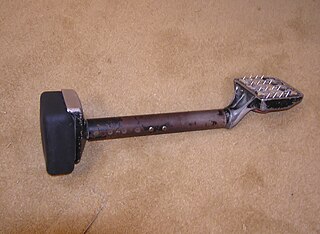 W
WFitted carpet, also wall-to-wall carpet or carpeting, is a carpet intended to cover a floor entirely. Carpet over 4 meters in length is usually installed with the use of a power-stretcher.
 W
WIn gymnastics, the floor refers to a specially prepared exercise surface, which is considered an apparatus. It is used by both male and female gymnasts. The event in gymnastics performed on floor is called floor exercise. The English abbreviation for the event in gymnastics scoring is FX.
 W
WA floor medallion is generally a centerpiece of flooring design that can be made with various flooring materials, including natural stone, wood, metal, tile, glass or a variety of other materials suitable for flooring. The pattern can be created using various methods such as mosaic, intarsia, and marquetry.
 W
WFloor sanding is the process of removing the top surfaces of a wooden floor by sanding with abrasive materials.
 W
WA floor scrubber is a floor cleaning device. It can be a simple tool such as a floor mop or floor brush, or in the form of a walk-behind or a ride-on machine to clean larger areas by injecting water with cleaning solution, scrubbing, and lifting the residue off the floor. With advancements in robotics, autonomous floor-scrubbing robots are available as well.
 W
WA floorcloth, or floor-cloth, is a cloth, normally of flannel, used for cleaning floors. The term was previously used also for materials used in place of carpeting or to protect expensive carpets, such as oilcloth, Kamptulicon, linoleum or other materials. This use is considered somewhat antiquated today, though do-it-yourself decorators still use floorcloths as a customizable alternative to rugs. Some artists have elected to use floorcloths as a medium of expression. Most modern floorcloths are made of heavy, unstretched canvas with two or more coats of gesso. They are then painted and varnished to make them waterproof.
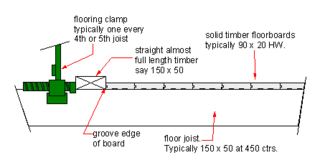 W
WClamps, or cramps, for laying tongue and groove floorboards, or flooring.
 W
WGlass floors are made with transparent glass when it is useful to view something from above or below; whereas translucent glass is used when there is no need to view through. In either case, toughened glass is usually chosen, for its durability and resistance to breakage.
 W
WGranolithic screed, also known as granolithic paving and granolithic concrete, is a type of construction material composed of cement and fine aggregate such as granite or other hard-wearing rock. It is generally used as flooring, or as paving. It has a similar appearance to concrete, and is used to provide a durable surface where texture and appearance are usually not important. It is commonly laid as a screed. Screeds are a type of flooring laid on top of the structural element to provide a level surface on which the "wearing flooring" is laid. A screed can also be laid bare, as it provides a long-lasting surface.
 W
WAn illuminated dance floor, LED dance floor or disco dance floor is a floor with panels or tiles that light up with different colours. They are used for dance. They were popularised for disco by the 1977 film Saturday Night Fever, which had gotten its inspiration from a floor that director John Badham had seen at "The Club", a private supper club in Birmingham, Alabama.
 W
WLaminate flooring is a multi-layer synthetic flooring product fused together with a lamination process. Laminate flooring simulates wood with a photographic applique layer under a clear protective layer. The inner core layer is usually composed of melamine resin and fiber board materials. There is a European Standard No. EN 13329:2000 specifying laminate floor covering requirements and testing methods.
 W
WLinoleum, commonly abbreviated to lino, is a floor covering made from materials such as solidified linseed oil (linoxyn), pine resin, ground cork dust, sawdust, and mineral fillers such as calcium carbonate, most commonly on a burlap or canvas backing. Pigments are often added to the materials to create the desired colour finish.
 W
WScreed has three meanings in building construction:a flat board or a purpose-made aluminium tool used to smooth and "true" materials like concrete, stucco and plaster after they have been placed on a surface or to assist in flattening; a strip of plaster or wood applied to a surface to act as a guide for a screed tool ; the material itself which has been flattened with a screed. In the UK, screed has also come to describe a thin, top layer of material, poured in site on top of the structural concrete or insulation, on top of which other finishing materials can be applied, or the structural material can be left bare to achieve a raw effect.
 W
WA mat is a piece of fabric material that generally is placed on a floor or other flat surface. Mats serve a range of purposes including:serving to clean items passed over it, such as a doormat, which removes dirt from the soles of shoes protecting that which is above the mat, such as a wrestling or gymnastics mat, or an anti-vibration mat protecting that which is beneath the mat, such as a place mat or the matting used in archival framing and preservation of documents and paintings providing a regular or flat surface, such as a cushioned computer mousepad
 W
WA mezzanine is, strictly speaking, an intermediate floor in a building which is partly open to the double-height ceilinged floor below, or which does not extend over the whole floorspace of the building. However, the term is often used loosely for the floor above the ground floor, especially where a very high original ground floor has been split horizontally into two floors.
 W
WA mop bucket cart is a wheeled bucket that allows its user to wring out a wet mop without getting the hands dirty. The cart has two buckets with the upper one usually clipped onto the lower.
 W
WNightingale floors listen (help·info) are floors that make a chirping sound when walked upon. These floors were used in the hallways of some temples and palaces, the most famous example being Nijō Castle, in Kyoto, Japan. Dry boards naturally creak under pressure, but these floors were built in a way that the flooring nails rub against a jacket or clamp, causing chirping noises. It is unclear if the design was intentional. It seems that, at least initially, the effect arose by chance. An information sign in Nijō castle states that "The singing sound is not actually intentional, stemming rather from the movement of nails against clumps in the floor caused by wear and tear over the years". Legend has it that the squeaking floors were used as a security device, assuring that none could sneak through the corridors undetected.
 W
WParquet is a geometric mosaic of wood pieces used for decorative effect in flooring.
 W
WThe piano nobile is the principal floor of a palazzo. This floor contains the main reception and bedrooms of the house.
 W
WPietra dura or pietre dure [ˈpjɛːtre ˈduːre], called parchin kari or parchinkari in the Indian Subcontinent, is a term for the inlay technique of using cut and fitted, highly polished colored stones to create images. It is considered a decorative art. The stonework, after the work is assembled loosely, is glued stone-by-stone to a substrate after having previously been "sliced and cut in different shape sections; and then assembled together so precisely that the contact between each section was practically invisible". Stability was achieved by grooving the undersides of the stones so that they interlocked, rather like a jigsaw puzzle, with everything held tautly in place by an encircling 'frame'. Many different colored stones, particularly marbles, were used, along with semiprecious, and even precious stones. It first appeared in Rome in the 16th century, reaching its full maturity in Florence. Pietra dura items are generally crafted on green, white or black marble base stones. Typically, the resulting panel is completely flat, but some examples where the image is in low relief were made, taking the work more into the area of hardstone carving.
 W
WPolished concrete is a multi-step process where a concrete floor is mechanically ground, honed and polished with bonded abrasives in order to cut a concrete floor's surface. It is then refined with each cut in order to achieve a specified level of appearance.
 W
WQuarter round is a convex molding with a cross section in the form of a quarter circle.
 W
WA raised floor provides an elevated structural floor above a solid substrate to create a hidden void for the passage of mechanical and electrical services. Raised floors are widely used in modern office buildings, and in specialized areas such as command centers, Information technology data centers and computer rooms, where there is a requirement to route mechanical services and cables, wiring, and electrical supply. Such flooring can be installed at varying heights from 2 inches (51 mm) to heights above 4 feet (1,200 mm) to suit services that may be accommodated beneath. Additional structural support and lighting are often provided when a floor is raised enough for a person to crawl or even walk beneath.
 W
WReed mats are handmade mats of plaited reed, made throughout most of Cambodia, India, and Thailand.
 W
WThe Resilient Floor Covering Institute (RFCI) is a U.S. industry trade group representing manufacturers of resilient flooring, primarily made of vinyl. It is headquartered in Rockville, Maryland.
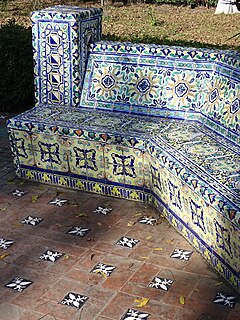 W
WSaltillo tile is a type of terracotta tile that originates in Saltillo, Coahuila, Mexico. It is one of the two most famous products of the city, the other being multi-coloured woven sarapes so typical of the region. Saltillo-type tiles are now manufactured at many places in Mexico, and high-fire "Saltillo look" tiles, many from Italy, compete with the terracotta originals.
 W
WScreed has three meanings in building construction:a flat board or a purpose-made aluminium tool used to smooth and "true" materials like concrete, stucco and plaster after they have been placed on a surface or to assist in flattening; a strip of plaster or wood applied to a surface to act as a guide for a screed tool ; the material itself which has been flattened with a screed. In the UK, screed has also come to describe a thin, top layer of material, poured in site on top of the structural concrete or insulation, on top of which other finishing materials can be applied, or the structural material can be left bare to achieve a raw effect.
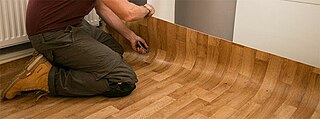 W
WSheet vinyl flooring is vinyl flooring that comes in large, continuous, flexible sheets. A vinyl sheet floor is completely impermeable to water, unlike vinyl floor tile, which comes in stiff tiles, and vinyl planks, which come in interlocking strips. It is sometimes called linoleum after a similar product of different chemical composition.
 W
WSitalpati, also called sital pati and sittal pati, is a kind of mat which feels cold by nature. It is made from murta plants. It is usually used in Bangladesh.Mats with decorative designs are called nakshi pati.
 W
WA solid ground floor consists of a layer of concrete, which in the case of a domestic building will be the surface layer brought up to ground floor level with hardcore filling under it. The advantage of a solid ground floor is the elimination of dry rot and other problems normally associated with hollow joisted floors. The disadvantage is that the floor is less resilient to walk upon and may be more tiring for the user. Solid ground floors are usually found or situated in a kitchen but will be necessary for other rooms where wood blocks and other similar finishes are required.
 W
WA stairway, staircase, stairwell, flight of stairs, or simply stairs, is a construction designed to bridge a large vertical distance by dividing it into smaller vertical distances, called steps. Stairs may be straight, round, or may consist of two or more straight pieces connected at angles.
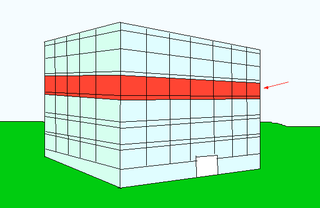 W
WA storey or story is any level part of a building with a floor that could be used by people. Plurals for the word are storeys (UK) and stories (US).
 W
WSustainable flooring is produced from sustainable materials that reduces demands on ecosystems during its life-cycle. This includes harvest, production, use and disposal. It is thought that sustainable flooring creates safer and healthier buildings and guarantees a future for traditional producers of renewable resources that many communities depend on. Several initiatives have led the charge to bring awareness of sustainable flooring as well as healthy buildings. Below are examples of available, though sometimes less well-known, eco-friendly flooring options. The Asthma and Allergy Foundation of America recommends those with allergies to dust or other particulates choose flooring with smooth surfaces – such as hardwood, vinyl, linoleum tile or slate.
 W
WA tatami (畳) is a type of mat used as a flooring material in traditional Japanese-style rooms. Tatami are made in standard sizes, twice as long as wide, about 0.9 m by 1.8 m depending on the region. In martial arts, tatami are the floor used for training in a dojo and for competition.
 W
WTerrazzo is a composite material, poured in place or precast, which is used for floor and wall treatments. It consists of chips of marble, quartz, granite, glass, or other suitable material, poured with a cementitious binder, polymeric, or a combination of both. Metal strips often divide sections, or changes in color or material in a pattern. Additional chips may be sprinkled atop the mix before it sets. After it is cured it is ground and polished smooth or otherwise finished to produce a uniformly textured surface. "Terrazzo" is also often used to describe any pattern similar to the original terrazzo floors.
 W
WThe thirteenth floor is a designation of a level of a multi-level building that is often omitted in countries where the number 13 is considered unlucky. Omitting the 13th floor may take a variety of forms; the most common include denoting what would otherwise be considered the thirteenth floor as level 14, giving the thirteenth floor an alternate designation such as "12A" or "M", or closing the 13th floor to public occupancy or access.
 W
WA tile is a thin object usually square or rectangular in shape. A tile is a manufactured piece of hard-wearing material such as ceramic, stone, metal, baked clay, or even glass, generally used for covering roofs, floors, walls, or other objects such as tabletops. Alternatively, tile can sometimes refer to similar units made from lightweight materials such as perlite, wood, and mineral wool, typically used for wall and ceiling applications. In another sense, a tile is a construction tile or similar object, such as rectangular counters used in playing games. The word is derived from the French word tuile, which is, in turn, from the Latin word tegula, meaning a roof tile composed of fired clay.
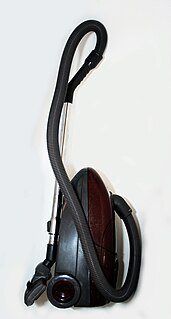 W
WA vacuum cleaner, also known simply as a vacuum or a hoover, is a device that causes suction in order to remove debris from floors, upholstery, draperies and other surfaces. It is generally electrically driven.
 W
WVinyl composition tile (VCT) is a finished flooring material used primarily in commercial and institutional applications. Modern vinyl floor tiles and sheet flooring and versions of those products sold since the early 1980s are composed of colored polyvinyl chloride (PVC) chips formed into solid sheets of varying thicknesses by heat and pressure. Floor tiles are cut into modular shapes such 12" x 12" squares or 12" x 24" rectangles. In installation the floor tiles or sheet flooring are applied to a smooth, leveled sub-floor using a specially formulated vinyl adhesive or tile mastic that remains pliable. In commercial applications some tiles are typically waxed and buffed using special materials and equipment.
 W
WVoided biaxial slabs, sometimes called biaxial slabs, are a type of reinforced concrete slab which incorporates air-filled voids to reduce the volume of concrete required. These voids enable cheaper construction and less environmental impact. Another major benefit of the system is its reduction in slab weight compared with regular solid decks. Up to 50% of the slab volume may be removed in voids, resulting in less load on structural members. This also allows increased weight and/or span, since the self-weight of the slab contributes less to the overall load.
 W
WWaffle slab is the most technical and economical type of roofs among conventional systems. The main element in the construction waffle slabs is waffle formwork. A waffle slab or two-way joist slab is a concrete slab made of reinforced concrete with concrete ribs running in two directions on its underside. The name waffle comes from the grid pattern created by the reinforcing ribs. Waffle slabs are preferred for spans greater than 40 feet (12 m), as they are much stronger than flat slabs, flat slabs with drop panels, two-way slabs, one-way slabs, and one-way joist slabs.
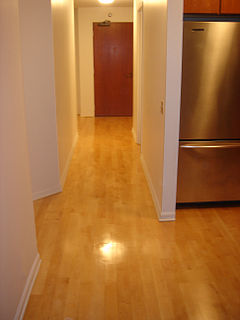 W
WWood flooring is any product manufactured from timber that is designed for use as flooring, either structural or aesthetic. Wood is a common choice as a flooring material and can come in various styles, colors, cuts, and species. Bamboo flooring is often considered a form of wood flooring, although it is made from a grass (bamboo) rather than a timber.